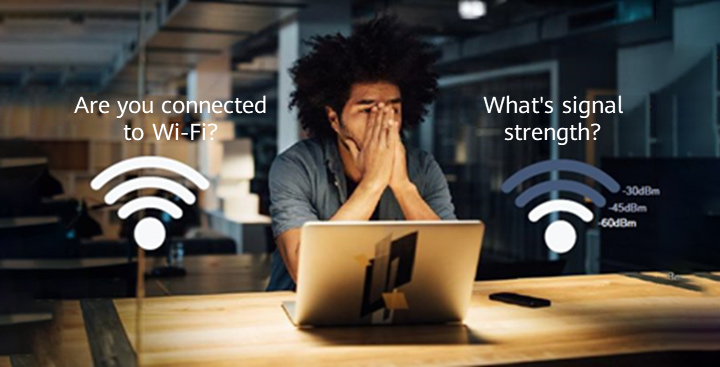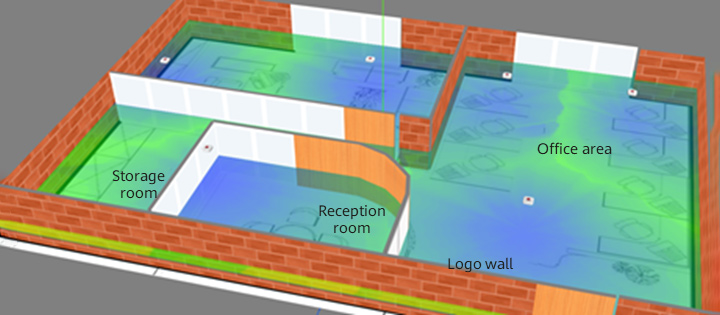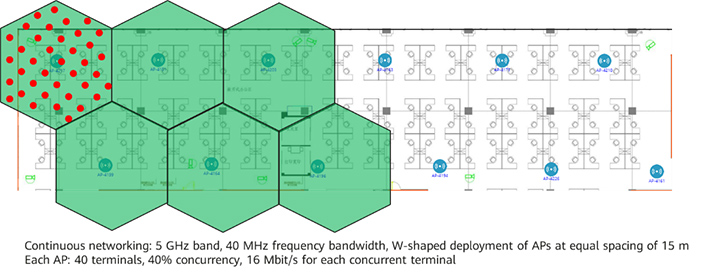Produkte, Lösungen und Services für Unternehmen
Smartphones, PCs & Tablets, Wearables, mobiles Breitband und mehr
Über Huawei, Nachrichten, Veranstaltungen, Brancheneinblicke und mehr
According to the Wi-Fi Alliance, more than 10 billion Wi-Fi devices are already in use worldwide. In fact, Wi-Fi carries more than half of today's data traffic. From workspaces to production environments, from the Earth's surface to space, Wi-Fi has been applied to all walks of life, permeating every corner of society.
Going forward, there are key questions that must be addressed. What issues are still encountered when using Wi-Fi? Are webpages unable to load, for example, even though the Wi-Fi signal is strong? When one user is downloading a video, do others suffer capped speeds? And are users only able to enjoy stable Wi-Fi connections when they are stationary?

With the proliferation of applications on mobile devices, the application experience has become crucial. And with each application demanding improved bandwidth and latency performance, user complaints are becoming more focused on a poor Wi-Fi experience.
Against this backdrop, enterprise Chief Information Officers (CIOs) are more concerned than ever before about how to improve the user experience in fully wireless workspaces, in order to minimize complaints. The user experience must be consistent regardless of place and regardless of device. Although such concerns seem simple to address, according to the International Data Corporation's (IDC's) latest enterprise wireless network maturity survey, 76% of today's enterprises worldwide remain dissatisfied with their wireless networks.
A further question naturally arises: does a viable wireless solution to effectively address these concerns already exist? A future-proofed Wireless Local Area Network (WLAN) is the answer, one that can truly sense environmental changes — such as crowd flows, interference, and partitions — all while dynamically evaluating the service experience. Connected to a WLAN such as this, users enjoy a consistent application experience anywhere and at any time, made possible thanks to fully wireless, continuous networking technology.
Conventional WLAN has inherent technical limitations and fails to meet the strict requirements of continuous networking with regards to coverage, capacity, interference, and roaming. For this reason, it cannot effectively resolve the issues that frequently arise: coverage holes, compromised performance at coverage edges, deteriorated access performance upon multi-terminal concurrency, network-wide co-channel interference, and in-roaming disconnection.
|
Key Focus |
Definition |
Conventional WLAN |
Wi-Fi 6 with Continuous Experience |
|
Coverage |
The coverage area of signals received by terminals. |
Coverage on demand: 2D planning leads to coverage holes in open spaces, such as aisles and break areas. |
Cellular-like: 3D planning ensures 100% coverage in workspaces. |
|
Capacity |
The number of terminals that can fully access services per unit coverage area. |
The concurrency of more terminals increases air interface conflicts, sharply impeding WLAN performance. |
The network dynamically senses concurrent terminal capacity and adjusts antenna angles and radio resources accordingly to ensure a smooth high-density access experience. |
|
Interference |
Signal interference between Access Points (APs), with similar or the same frequency, on a wireless network lowers the Signal-to-Noise Ratio (SNR) of terminals, ultimately impacting the user experience. |
Only a few channels are available on the 2.4 GHz band and the default channel settings are used on the 5 GHz band. As a result, co-channel networking suffers from severe interference and manual adjustment is time-consuming. |
The network dynamically senses historical access behavior and loads, and intelligently optimizes AP indicators, such as channels, frequency bandwidth, and transmit power. It achieves optimal performance across the entire network. |
|
Roaming |
Terminal movement — without service interruptions — from one AP to another. |
After movement, the terminal remains connected to the original AP and does not switch to a new one in time, leading to a weak signal and poor performance. |
The network proactively learns the roaming habits of different terminals and actively matches their movement, providing more accurate, rapid, and stable access. |
The short answer is no.
Wi-Fi 6, also known as IEEE 802.11ax, is the sixth generation of Wi-Fi, as its name suggests. By using uplink Multi-User Multiple Input Multiple Output (MU-MIMO) and Orthogonal Frequency Division Multiple Access (OFDMA) subcarrier technologies, Wi-Fi 6 better utilizes spatial radio resources and improves the multi-user concurrency experience per unit coverage area. The majority of today's new smart devices also support 802.11k/v/r protocols, further improving the roaming experience for users.
Although these technologies provide the foundation to achieve wireless continuous networking, they simply revolve around single APs and cannot resolve the experience issues in multi-AP networking environments. In addition, they do not address legacy roaming mechanism issues: roaming requests are still initiated by terminals, and the distinct roaming behavior of terminals cannot be controlled. This means that once terminals are introduced to the wireless network, a reliable user experience is still not ensured.
But the foundation is there. With a few tweaks, a continuous Wi-Fi 6 experience can be achieved.
Huawei believes that future-proofed wireless networks need to be more intelligent than ever. Wi-Fi 6 technology has increased single-AP performance to a record high. Integrating telemetry and Artificial Intelligence (AI) technologies with Wi-Fi 6 paves the way for a digital wireless network that can effectively sense changes to the environment and terminals. On top of this, AI inference can be used to calculate the optimal Key Performance Indicators (KPIs), helping to achieve the best experience across the entire wireless network.
With all this in mind, Huawei has contributed an extensive range of innovations to make wireless networks more intelligent.
Unique 3D WLAN network planning and AI-powered real-time network simulation ensure full wireless signals at every corner. Huawei's WLAN Planner, a feature-rich 3D network planning tool, can directly read the floor plan of an onsite environment and allow users to flexibly define multiple types of partitions with various materials. Additionally, this tool automatically recommends the most appropriate AP models based on selected scenarios. With built-in simulation algorithms, WLAN Planner delivers high-precision signal coverage simulation and even intuitively gains insight into the roaming experience. In short, advanced network planning is handed over to this intelligent system.

Figure 1: 3D network planning and AI-powered network simulation
Next generation Dynamic-Zoom Smart Antennas create reliable connections for each terminal by intelligently sensing terminal density in the network access environment. Dynamic-Zoom Smart Antennas flexibly work in omnidirectional or high-density coverage scenarios, adapting fluidly to the demands of crowds for a wide range of coverage, or a smooth high-density access experience. When user access density increases, the AP quickly reduces the angle of Smart Antennas. At the same time, it draws on Smart Antenna training algorithms and high-performance reflector technologies to minimize signal interference at the edge. As a result, performance is ultimately improved by over 20%.

Figure 2: Performance comparison before and after angle switching by Dynamic-Zoom Smart Antennas
Unique to Huawei, AI-powered intelligent radio calibration technology predicts future changes based on historical data, doing so to perform predictive automatic optimization, ensuring an optimal user experience across the entire network. This technology, combined with the intelligent Operations and Maintenance (O&M) system — iMaster NCE-CampusInsight — proactively detects environmental changes, optimizes radio resources based on network traffic, and reduces co-channel and adjacent-channel interference. As a result, the network-wide experience is intelligently optimized to improve performance by up to 58%.

Figure 3: Comparison before and after intelligent radio calibration is used (source: Tolly Group report)
AI roaming technology, another differentiator of Huawei Wi-Fi 6, learns the roaming behavior of each terminal in order to avoid interruptions even when moving around corners. By identifying terminal types and learning their roaming habits, this technology formulates differentiated terminal roaming policies and parameters, allowing it to actively steer terminal roaming. In this way, terminals of each type experience optimal roaming, and the roaming success rate reaches a record high of over 95%.

Figure 4: Roaming success rate comparison before and after AI roaming is introduced
These exemplary innovations are just a glimpse into Huawei's ongoing efforts to achieve fully wireless intelligent continuous networking for an unmatched experience. Huawei goes beyond the Wi-Fi 6 standard, perceptively innovating groundbreaking networking technologies and network optimization practices to address the pain points within enterprises' fully-wireless networks.
With long-term research conducted on wireless networks and customer experience data analytics from the field, Huawei WLAN teams have taken the lead in proposing the concept of "fully-wireless, continuous, gigabit networking anytime, anywhere." This underscores Huawei's efforts to ensure seamless user access and a consistent experience.
Currently, Huawei has built and verified a ubiquitous 100 Mbit/s to 300 Mbit/s wireless network for its offices, totaling tens of thousands of square meters. Specifically, in office scenarios, the recommended 100 Mbit/s continuous networking standard shown in Figure 5 delivers indispensable benefits: a terminal can achieve 100 Mbit/s in 95% of an AP's coverage area (namely, the red dots in Figure 5).

Figure 5: 100 Mbit/s continuous networking in the office area
Huawei's Intelligent Continuous Networking Solution builds on Huawei AirEngine APs and iMaster NCE-CampusInsight. It is purpose-designed to build future-proofed, fully wireless networks. It is no wonder, then, why so many businesses — across the education, healthcare, hospitality, airport, factory, warehousing, and stadium sectors — have already adopted this solution.
If you are interested in Huawei's intelligent continuous networking technologies, feel free to download our Huawei Wi-Fi 6 Continuous Networking Technology White Paper and Huawei iMaster CampusInsight Intelligent O&M Technology White Paper.
Huawei never ceases to innovate wireless networking technologies and, in doing so, is committed to helping enterprises build fully wireless networks featuring all things connected, an optimal experience, and always-on services. With Huawei's help, enterprises can benefit from more efficient, stable, and effective office and production services.
Disclaimer: The views and opinions expressed in this article are those of the author and do not necessarily reflect the official policy, position, products, and technologies of Huawei Technologies Co., Ltd. If you need to learn more about the products and technologies of Huawei Technologies Co., Ltd., please visit our website at e.huawei.com or contact us.